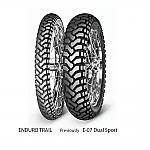Air pressure
Always maintain the recommended tire pressure for the type of terrain on which the motorcycle is being ridden; check the owner’s manual. Under-inflated tires may cause wheel damage when ridden on rocky, rough terrain and allow the motorcycle to squirm or wander on smooth, hard terrain. Over-inflation may damage the tires and cause an unnecessarily harsh ride. To accurately measure tire pressure, use a standard tire-pressure gauge.
- For fully loaded or dual-riding touring-motorcycle applications, inflate tires to the maximum pressure recommended by the motorcycle manufacturer. And never exceed maximum load capacity indicated on the tire’s sidewall or the motorcycles capacity load found in the owner’s manual. A good rule of thumb is to use whichever maximum load recommendation is lower if the manual or tire sidewalls have different max capacities.
- Under-inflated tires can result in imprecise cornering, higher running temperatures, irregular tread wear, fatigue cracking, over-stressing and eventual failure of the tire carcass, all of which could lead to, at some point, loss of control of the motorcycle.
- Over-inflating tires does not increase load-carrying capacity, but will result in a hard ride and accelerated tire wear in the center of the contact patch. Check cold tire pressure frequently with a good-quality gauge that holds a reading, and always before extended trips.
Condition
Check for cuts and gouges that may cause air leakage. Also check the tires for missing knobs and excessive wear.
- Loss of pressure may occur due to worn-out or badly seated valve cores. Check valve cores, and if necessary, tighten for correct seating, or remove and replace them. A metal or hard-plastic valve cap with an inner gasket should be used and installed finger-tight to protect the valve core from dust and moisture and to help maintain a positive air seal.
- Tube damage, as well as cracked rubber tube or tubeless valve stem bases, may also cause loss of pressure. Inspect rim bands, tubes and valves. Replace if damage or cracking is noted.
- Repeated loss of pressure may result from undetected tire damage. Visually inspect tires for punctures, cuts, abrasions, cracks, bulges, blisters or knots. It will be necessary to dismount the tire to complete an inspection for internal damage and any need for repair. Only certain punctures in the tread area may be repaired, and only if no other damage is present.
- Always seek expert inspection of the dismounted tire following curb, chuckhole or other impacts, evidence of penetration beyond the tire surface, bulges or low pressure. You should not continue riding on such tires.
Wheels
To avoid loss of control or injury, make sure axle nuts are tight and secure. Grasp each tire at the front and rear and try to rock it on its axle to detect worn-out bearings or loose nuts. There should be no free play or slip as you rock the wheel. Inspect wheels for broken or loose spokes and for cracks on the hub or rim.







 View Order / Checkout
View Order / Checkout Continue Shopping
Continue Shopping